Leadership in Healthcare: Analysis of Change Management Strategies
VerifiedAdded on 2020/05/04
|12
|3188
|70
Report
AI Summary
This report critically examines the role of leadership in driving positive change within a healthcare system, specifically focusing on the implementation of Cyber Security For Medical Devices (CSFMD) at a Texas hospital. The paper analyzes the application of transformational leadership, highlighting the strategies employed, such as positive communication and team management, while also identifying the challenges encountered, including team member apprehension and lack of coordination. The report discusses the use of Kurt Lewin’s change management model to address these barriers and evaluates the ethical implications of the leadership approach, including considerations for stakeholder consultation and motivational strategies. The outcomes of the leadership style are assessed in terms of achieving the proposed change and overcoming implementation issues. Furthermore, the report provides an analysis of the decisions made around the planned change, considering the criticisms of transformational leadership, such as its potential for elitism and manipulation, and offers recommendations for future leadership practices. The report provides a comprehensive overview of the leadership challenges, strategies, and outcomes involved in implementing change within a healthcare environment, with a critical evaluation of the ethical considerations and leadership styles employed.
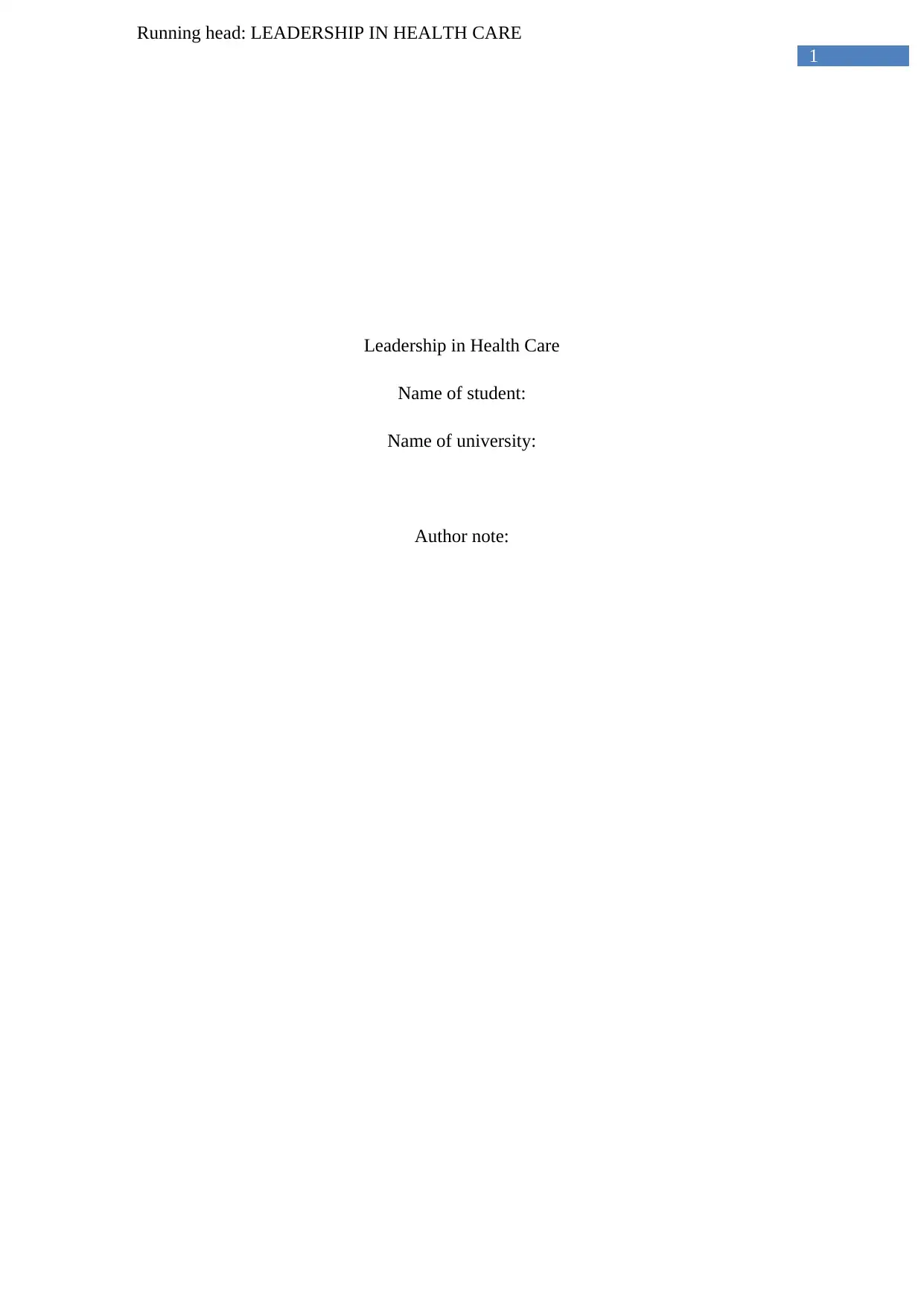
1
Running head: LEADERSHIP IN HEALTH CARE
Leadership in Health Care
Name of student:
Name of university:
Author note:
Running head: LEADERSHIP IN HEALTH CARE
Leadership in Health Care
Name of student:
Name of university:
Author note:
Paraphrase This Document
Need a fresh take? Get an instant paraphrase of this document with our AI Paraphraser
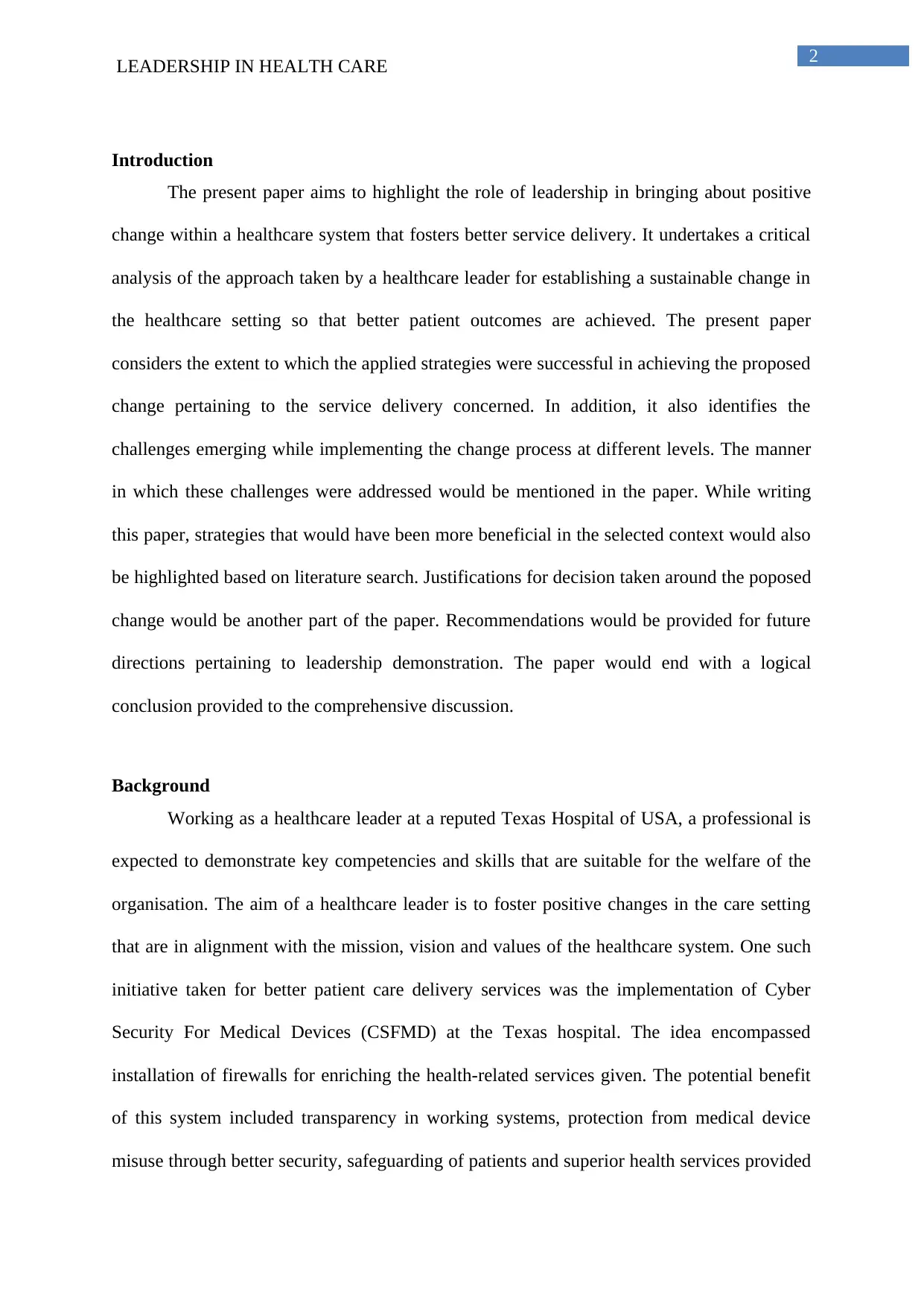
2
LEADERSHIP IN HEALTH CARE
Introduction
The present paper aims to highlight the role of leadership in bringing about positive
change within a healthcare system that fosters better service delivery. It undertakes a critical
analysis of the approach taken by a healthcare leader for establishing a sustainable change in
the healthcare setting so that better patient outcomes are achieved. The present paper
considers the extent to which the applied strategies were successful in achieving the proposed
change pertaining to the service delivery concerned. In addition, it also identifies the
challenges emerging while implementing the change process at different levels. The manner
in which these challenges were addressed would be mentioned in the paper. While writing
this paper, strategies that would have been more beneficial in the selected context would also
be highlighted based on literature search. Justifications for decision taken around the poposed
change would be another part of the paper. Recommendations would be provided for future
directions pertaining to leadership demonstration. The paper would end with a logical
conclusion provided to the comprehensive discussion.
Background
Working as a healthcare leader at a reputed Texas Hospital of USA, a professional is
expected to demonstrate key competencies and skills that are suitable for the welfare of the
organisation. The aim of a healthcare leader is to foster positive changes in the care setting
that are in alignment with the mission, vision and values of the healthcare system. One such
initiative taken for better patient care delivery services was the implementation of Cyber
Security For Medical Devices (CSFMD) at the Texas hospital. The idea encompassed
installation of firewalls for enriching the health-related services given. The potential benefit
of this system included transparency in working systems, protection from medical device
misuse through better security, safeguarding of patients and superior health services provided
LEADERSHIP IN HEALTH CARE
Introduction
The present paper aims to highlight the role of leadership in bringing about positive
change within a healthcare system that fosters better service delivery. It undertakes a critical
analysis of the approach taken by a healthcare leader for establishing a sustainable change in
the healthcare setting so that better patient outcomes are achieved. The present paper
considers the extent to which the applied strategies were successful in achieving the proposed
change pertaining to the service delivery concerned. In addition, it also identifies the
challenges emerging while implementing the change process at different levels. The manner
in which these challenges were addressed would be mentioned in the paper. While writing
this paper, strategies that would have been more beneficial in the selected context would also
be highlighted based on literature search. Justifications for decision taken around the poposed
change would be another part of the paper. Recommendations would be provided for future
directions pertaining to leadership demonstration. The paper would end with a logical
conclusion provided to the comprehensive discussion.
Background
Working as a healthcare leader at a reputed Texas Hospital of USA, a professional is
expected to demonstrate key competencies and skills that are suitable for the welfare of the
organisation. The aim of a healthcare leader is to foster positive changes in the care setting
that are in alignment with the mission, vision and values of the healthcare system. One such
initiative taken for better patient care delivery services was the implementation of Cyber
Security For Medical Devices (CSFMD) at the Texas hospital. The idea encompassed
installation of firewalls for enriching the health-related services given. The potential benefit
of this system included transparency in working systems, protection from medical device
misuse through better security, safeguarding of patients and superior health services provided
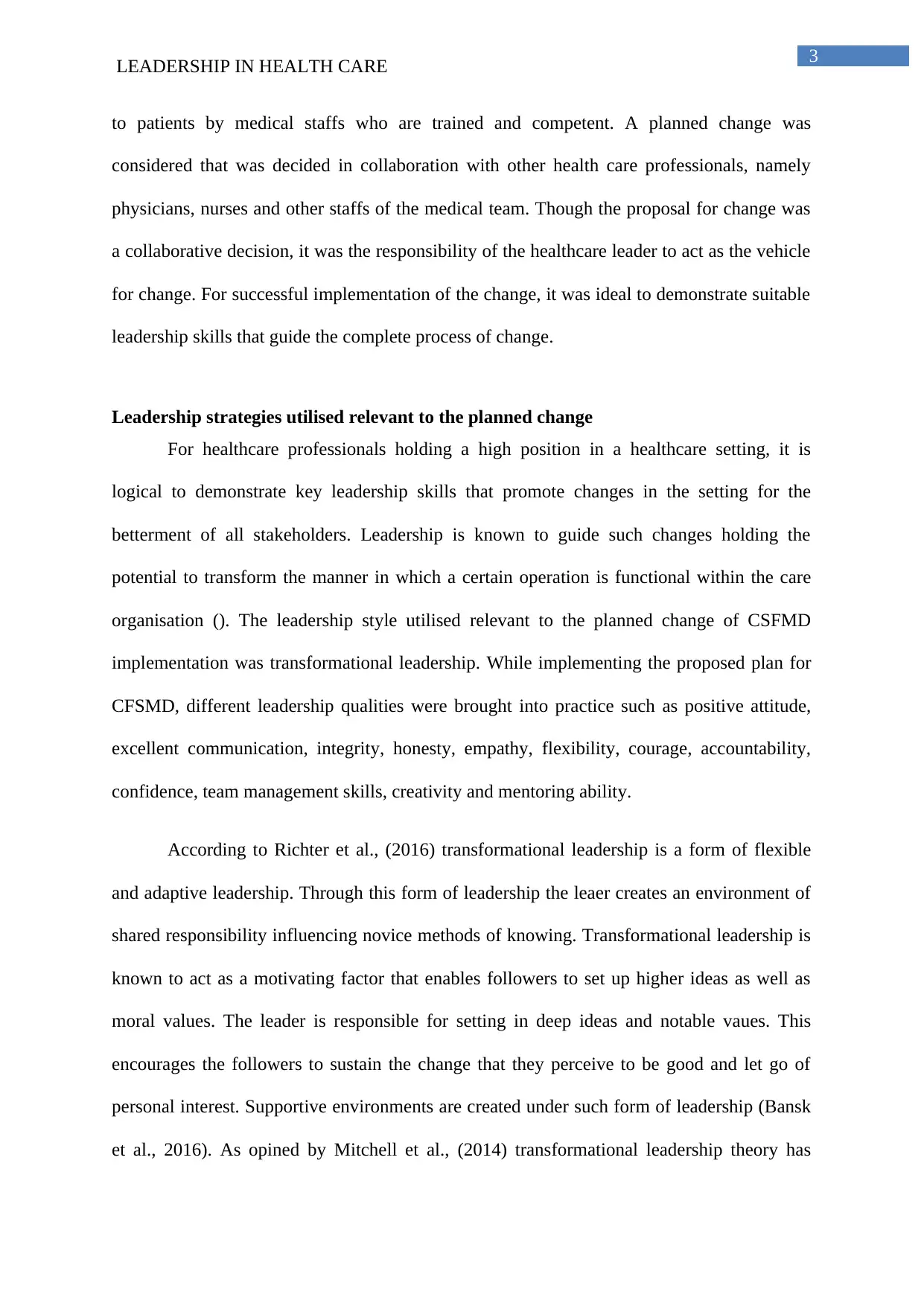
3
LEADERSHIP IN HEALTH CARE
to patients by medical staffs who are trained and competent. A planned change was
considered that was decided in collaboration with other health care professionals, namely
physicians, nurses and other staffs of the medical team. Though the proposal for change was
a collaborative decision, it was the responsibility of the healthcare leader to act as the vehicle
for change. For successful implementation of the change, it was ideal to demonstrate suitable
leadership skills that guide the complete process of change.
Leadership strategies utilised relevant to the planned change
For healthcare professionals holding a high position in a healthcare setting, it is
logical to demonstrate key leadership skills that promote changes in the setting for the
betterment of all stakeholders. Leadership is known to guide such changes holding the
potential to transform the manner in which a certain operation is functional within the care
organisation (). The leadership style utilised relevant to the planned change of CSFMD
implementation was transformational leadership. While implementing the proposed plan for
CFSMD, different leadership qualities were brought into practice such as positive attitude,
excellent communication, integrity, honesty, empathy, flexibility, courage, accountability,
confidence, team management skills, creativity and mentoring ability.
According to Richter et al., (2016) transformational leadership is a form of flexible
and adaptive leadership. Through this form of leadership the leaer creates an environment of
shared responsibility influencing novice methods of knowing. Transformational leadership is
known to act as a motivating factor that enables followers to set up higher ideas as well as
moral values. The leader is responsible for setting in deep ideas and notable vaues. This
encourages the followers to sustain the change that they perceive to be good and let go of
personal interest. Supportive environments are created under such form of leadership (Bansk
et al., 2016). As opined by Mitchell et al., (2014) transformational leadership theory has
LEADERSHIP IN HEALTH CARE
to patients by medical staffs who are trained and competent. A planned change was
considered that was decided in collaboration with other health care professionals, namely
physicians, nurses and other staffs of the medical team. Though the proposal for change was
a collaborative decision, it was the responsibility of the healthcare leader to act as the vehicle
for change. For successful implementation of the change, it was ideal to demonstrate suitable
leadership skills that guide the complete process of change.
Leadership strategies utilised relevant to the planned change
For healthcare professionals holding a high position in a healthcare setting, it is
logical to demonstrate key leadership skills that promote changes in the setting for the
betterment of all stakeholders. Leadership is known to guide such changes holding the
potential to transform the manner in which a certain operation is functional within the care
organisation (). The leadership style utilised relevant to the planned change of CSFMD
implementation was transformational leadership. While implementing the proposed plan for
CFSMD, different leadership qualities were brought into practice such as positive attitude,
excellent communication, integrity, honesty, empathy, flexibility, courage, accountability,
confidence, team management skills, creativity and mentoring ability.
According to Richter et al., (2016) transformational leadership is a form of flexible
and adaptive leadership. Through this form of leadership the leaer creates an environment of
shared responsibility influencing novice methods of knowing. Transformational leadership is
known to act as a motivating factor that enables followers to set up higher ideas as well as
moral values. The leader is responsible for setting in deep ideas and notable vaues. This
encourages the followers to sustain the change that they perceive to be good and let go of
personal interest. Supportive environments are created under such form of leadership (Bansk
et al., 2016). As opined by Mitchell et al., (2014) transformational leadership theory has
⊘ This is a preview!⊘
Do you want full access?
Subscribe today to unlock all pages.

Trusted by 1+ million students worldwide
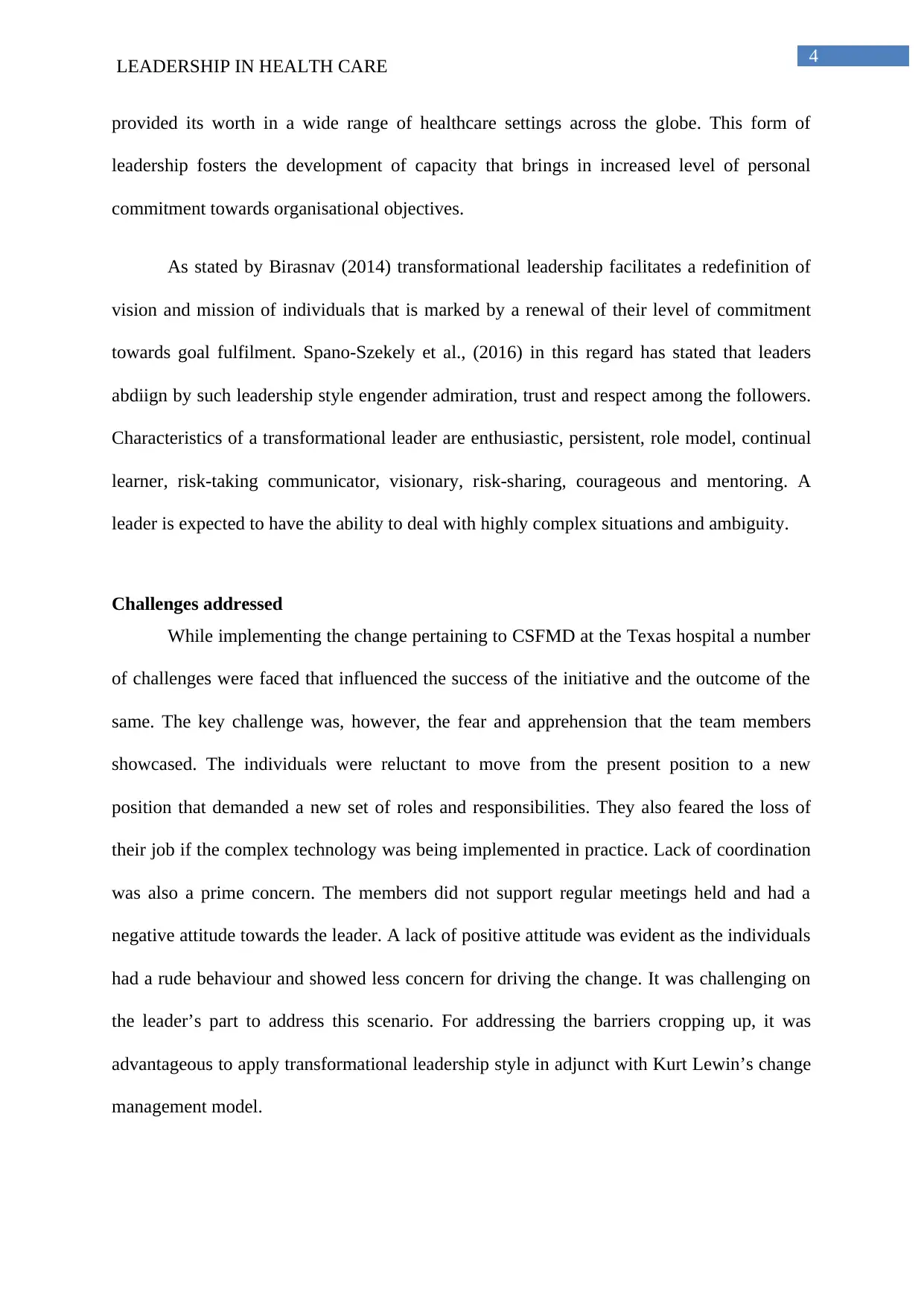
4
LEADERSHIP IN HEALTH CARE
provided its worth in a wide range of healthcare settings across the globe. This form of
leadership fosters the development of capacity that brings in increased level of personal
commitment towards organisational objectives.
As stated by Birasnav (2014) transformational leadership facilitates a redefinition of
vision and mission of individuals that is marked by a renewal of their level of commitment
towards goal fulfilment. Spano-Szekely et al., (2016) in this regard has stated that leaders
abdiign by such leadership style engender admiration, trust and respect among the followers.
Characteristics of a transformational leader are enthusiastic, persistent, role model, continual
learner, risk-taking communicator, visionary, risk-sharing, courageous and mentoring. A
leader is expected to have the ability to deal with highly complex situations and ambiguity.
Challenges addressed
While implementing the change pertaining to CSFMD at the Texas hospital a number
of challenges were faced that influenced the success of the initiative and the outcome of the
same. The key challenge was, however, the fear and apprehension that the team members
showcased. The individuals were reluctant to move from the present position to a new
position that demanded a new set of roles and responsibilities. They also feared the loss of
their job if the complex technology was being implemented in practice. Lack of coordination
was also a prime concern. The members did not support regular meetings held and had a
negative attitude towards the leader. A lack of positive attitude was evident as the individuals
had a rude behaviour and showed less concern for driving the change. It was challenging on
the leader’s part to address this scenario. For addressing the barriers cropping up, it was
advantageous to apply transformational leadership style in adjunct with Kurt Lewin’s change
management model.
LEADERSHIP IN HEALTH CARE
provided its worth in a wide range of healthcare settings across the globe. This form of
leadership fosters the development of capacity that brings in increased level of personal
commitment towards organisational objectives.
As stated by Birasnav (2014) transformational leadership facilitates a redefinition of
vision and mission of individuals that is marked by a renewal of their level of commitment
towards goal fulfilment. Spano-Szekely et al., (2016) in this regard has stated that leaders
abdiign by such leadership style engender admiration, trust and respect among the followers.
Characteristics of a transformational leader are enthusiastic, persistent, role model, continual
learner, risk-taking communicator, visionary, risk-sharing, courageous and mentoring. A
leader is expected to have the ability to deal with highly complex situations and ambiguity.
Challenges addressed
While implementing the change pertaining to CSFMD at the Texas hospital a number
of challenges were faced that influenced the success of the initiative and the outcome of the
same. The key challenge was, however, the fear and apprehension that the team members
showcased. The individuals were reluctant to move from the present position to a new
position that demanded a new set of roles and responsibilities. They also feared the loss of
their job if the complex technology was being implemented in practice. Lack of coordination
was also a prime concern. The members did not support regular meetings held and had a
negative attitude towards the leader. A lack of positive attitude was evident as the individuals
had a rude behaviour and showed less concern for driving the change. It was challenging on
the leader’s part to address this scenario. For addressing the barriers cropping up, it was
advantageous to apply transformational leadership style in adjunct with Kurt Lewin’s change
management model.
Paraphrase This Document
Need a fresh take? Get an instant paraphrase of this document with our AI Paraphraser
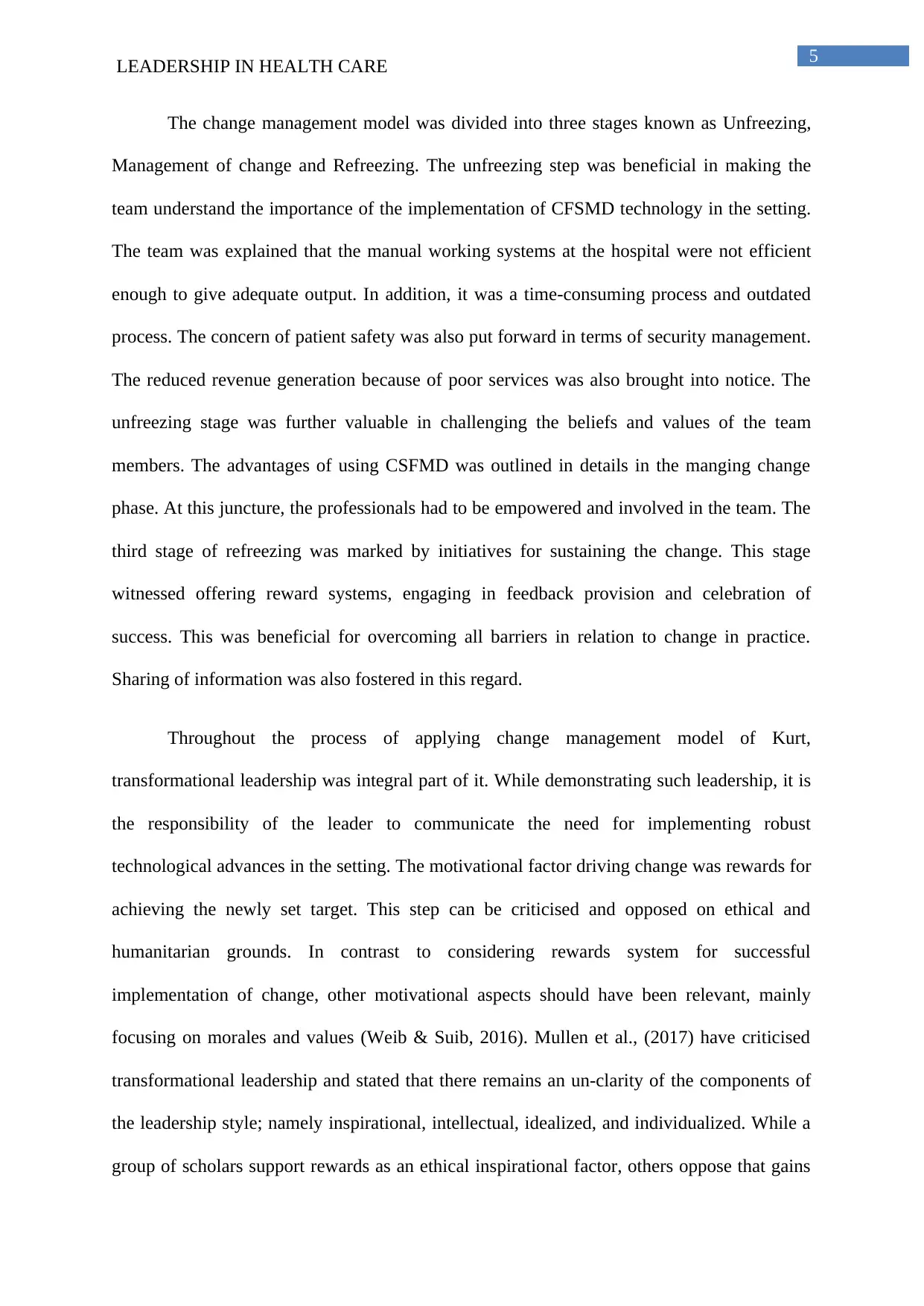
5
LEADERSHIP IN HEALTH CARE
The change management model was divided into three stages known as Unfreezing,
Management of change and Refreezing. The unfreezing step was beneficial in making the
team understand the importance of the implementation of CFSMD technology in the setting.
The team was explained that the manual working systems at the hospital were not efficient
enough to give adequate output. In addition, it was a time-consuming process and outdated
process. The concern of patient safety was also put forward in terms of security management.
The reduced revenue generation because of poor services was also brought into notice. The
unfreezing stage was further valuable in challenging the beliefs and values of the team
members. The advantages of using CSFMD was outlined in details in the manging change
phase. At this juncture, the professionals had to be empowered and involved in the team. The
third stage of refreezing was marked by initiatives for sustaining the change. This stage
witnessed offering reward systems, engaging in feedback provision and celebration of
success. This was beneficial for overcoming all barriers in relation to change in practice.
Sharing of information was also fostered in this regard.
Throughout the process of applying change management model of Kurt,
transformational leadership was integral part of it. While demonstrating such leadership, it is
the responsibility of the leader to communicate the need for implementing robust
technological advances in the setting. The motivational factor driving change was rewards for
achieving the newly set target. This step can be criticised and opposed on ethical and
humanitarian grounds. In contrast to considering rewards system for successful
implementation of change, other motivational aspects should have been relevant, mainly
focusing on morales and values (Weib & Suib, 2016). Mullen et al., (2017) have criticised
transformational leadership and stated that there remains an un-clarity of the components of
the leadership style; namely inspirational, intellectual, idealized, and individualized. While a
group of scholars support rewards as an ethical inspirational factor, others oppose that gains
LEADERSHIP IN HEALTH CARE
The change management model was divided into three stages known as Unfreezing,
Management of change and Refreezing. The unfreezing step was beneficial in making the
team understand the importance of the implementation of CFSMD technology in the setting.
The team was explained that the manual working systems at the hospital were not efficient
enough to give adequate output. In addition, it was a time-consuming process and outdated
process. The concern of patient safety was also put forward in terms of security management.
The reduced revenue generation because of poor services was also brought into notice. The
unfreezing stage was further valuable in challenging the beliefs and values of the team
members. The advantages of using CSFMD was outlined in details in the manging change
phase. At this juncture, the professionals had to be empowered and involved in the team. The
third stage of refreezing was marked by initiatives for sustaining the change. This stage
witnessed offering reward systems, engaging in feedback provision and celebration of
success. This was beneficial for overcoming all barriers in relation to change in practice.
Sharing of information was also fostered in this regard.
Throughout the process of applying change management model of Kurt,
transformational leadership was integral part of it. While demonstrating such leadership, it is
the responsibility of the leader to communicate the need for implementing robust
technological advances in the setting. The motivational factor driving change was rewards for
achieving the newly set target. This step can be criticised and opposed on ethical and
humanitarian grounds. In contrast to considering rewards system for successful
implementation of change, other motivational aspects should have been relevant, mainly
focusing on morales and values (Weib & Suib, 2016). Mullen et al., (2017) have criticised
transformational leadership and stated that there remains an un-clarity of the components of
the leadership style; namely inspirational, intellectual, idealized, and individualized. While a
group of scholars support rewards as an ethical inspirational factor, others oppose that gains
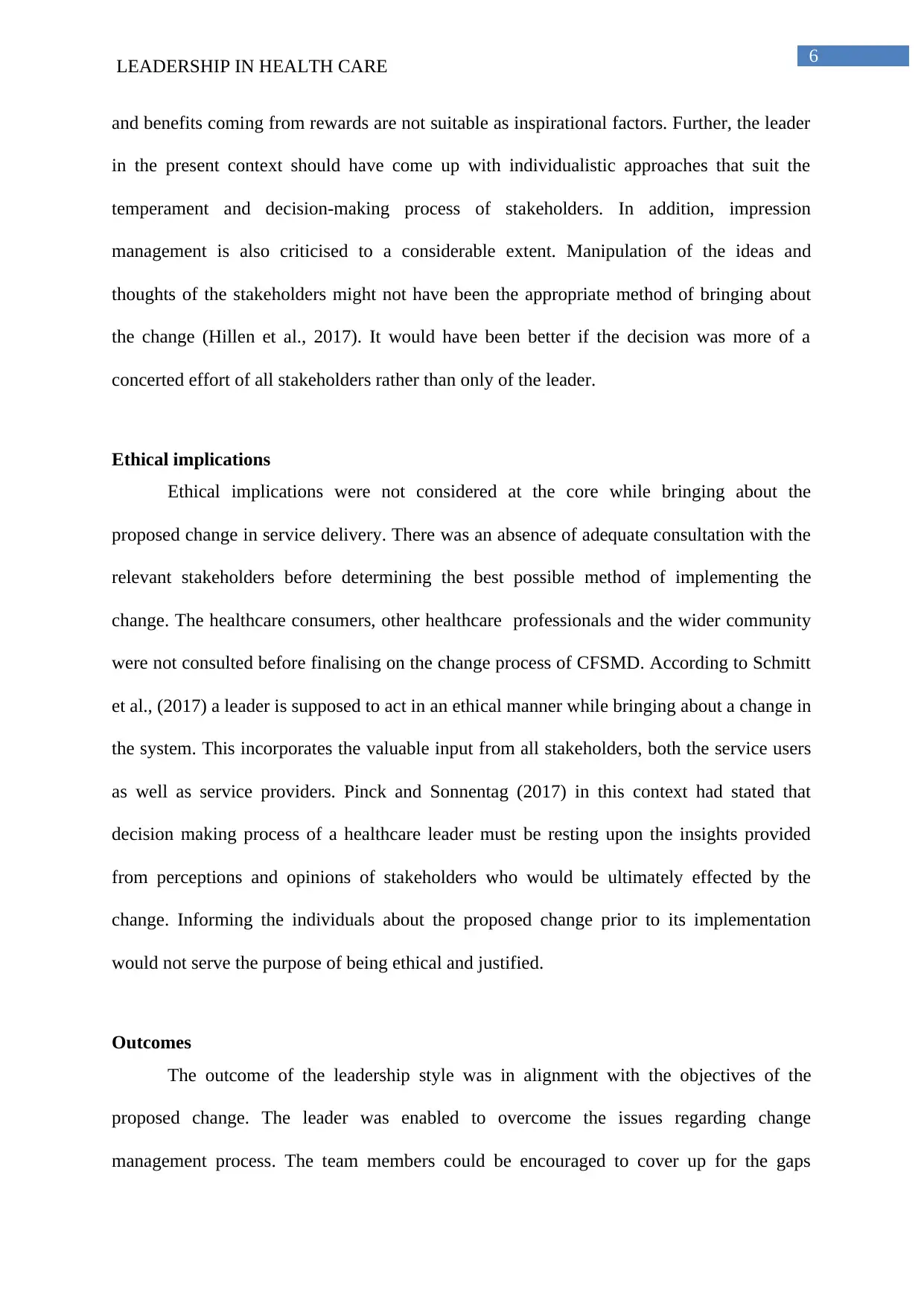
6
LEADERSHIP IN HEALTH CARE
and benefits coming from rewards are not suitable as inspirational factors. Further, the leader
in the present context should have come up with individualistic approaches that suit the
temperament and decision-making process of stakeholders. In addition, impression
management is also criticised to a considerable extent. Manipulation of the ideas and
thoughts of the stakeholders might not have been the appropriate method of bringing about
the change (Hillen et al., 2017). It would have been better if the decision was more of a
concerted effort of all stakeholders rather than only of the leader.
Ethical implications
Ethical implications were not considered at the core while bringing about the
proposed change in service delivery. There was an absence of adequate consultation with the
relevant stakeholders before determining the best possible method of implementing the
change. The healthcare consumers, other healthcare professionals and the wider community
were not consulted before finalising on the change process of CFSMD. According to Schmitt
et al., (2017) a leader is supposed to act in an ethical manner while bringing about a change in
the system. This incorporates the valuable input from all stakeholders, both the service users
as well as service providers. Pinck and Sonnentag (2017) in this context had stated that
decision making process of a healthcare leader must be resting upon the insights provided
from perceptions and opinions of stakeholders who would be ultimately effected by the
change. Informing the individuals about the proposed change prior to its implementation
would not serve the purpose of being ethical and justified.
Outcomes
The outcome of the leadership style was in alignment with the objectives of the
proposed change. The leader was enabled to overcome the issues regarding change
management process. The team members could be encouraged to cover up for the gaps
LEADERSHIP IN HEALTH CARE
and benefits coming from rewards are not suitable as inspirational factors. Further, the leader
in the present context should have come up with individualistic approaches that suit the
temperament and decision-making process of stakeholders. In addition, impression
management is also criticised to a considerable extent. Manipulation of the ideas and
thoughts of the stakeholders might not have been the appropriate method of bringing about
the change (Hillen et al., 2017). It would have been better if the decision was more of a
concerted effort of all stakeholders rather than only of the leader.
Ethical implications
Ethical implications were not considered at the core while bringing about the
proposed change in service delivery. There was an absence of adequate consultation with the
relevant stakeholders before determining the best possible method of implementing the
change. The healthcare consumers, other healthcare professionals and the wider community
were not consulted before finalising on the change process of CFSMD. According to Schmitt
et al., (2017) a leader is supposed to act in an ethical manner while bringing about a change in
the system. This incorporates the valuable input from all stakeholders, both the service users
as well as service providers. Pinck and Sonnentag (2017) in this context had stated that
decision making process of a healthcare leader must be resting upon the insights provided
from perceptions and opinions of stakeholders who would be ultimately effected by the
change. Informing the individuals about the proposed change prior to its implementation
would not serve the purpose of being ethical and justified.
Outcomes
The outcome of the leadership style was in alignment with the objectives of the
proposed change. The leader was enabled to overcome the issues regarding change
management process. The team members could be encouraged to cover up for the gaps
⊘ This is a preview!⊘
Do you want full access?
Subscribe today to unlock all pages.

Trusted by 1+ million students worldwide
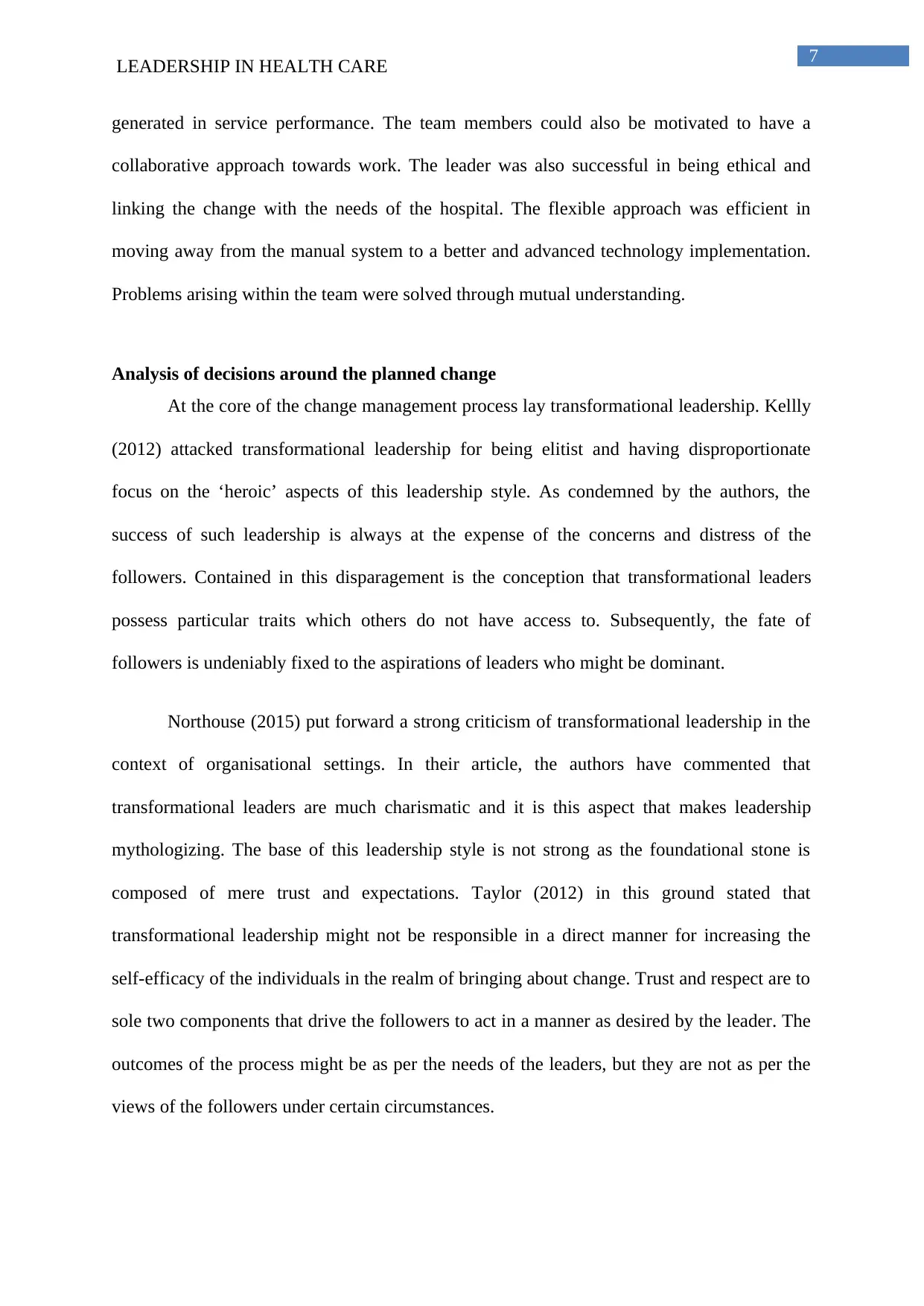
7
LEADERSHIP IN HEALTH CARE
generated in service performance. The team members could also be motivated to have a
collaborative approach towards work. The leader was also successful in being ethical and
linking the change with the needs of the hospital. The flexible approach was efficient in
moving away from the manual system to a better and advanced technology implementation.
Problems arising within the team were solved through mutual understanding.
Analysis of decisions around the planned change
At the core of the change management process lay transformational leadership. Kellly
(2012) attacked transformational leadership for being elitist and having disproportionate
focus on the ‘heroic’ aspects of this leadership style. As condemned by the authors, the
success of such leadership is always at the expense of the concerns and distress of the
followers. Contained in this disparagement is the conception that transformational leaders
possess particular traits which others do not have access to. Subsequently, the fate of
followers is undeniably fixed to the aspirations of leaders who might be dominant.
Northouse (2015) put forward a strong criticism of transformational leadership in the
context of organisational settings. In their article, the authors have commented that
transformational leaders are much charismatic and it is this aspect that makes leadership
mythologizing. The base of this leadership style is not strong as the foundational stone is
composed of mere trust and expectations. Taylor (2012) in this ground stated that
transformational leadership might not be responsible in a direct manner for increasing the
self-efficacy of the individuals in the realm of bringing about change. Trust and respect are to
sole two components that drive the followers to act in a manner as desired by the leader. The
outcomes of the process might be as per the needs of the leaders, but they are not as per the
views of the followers under certain circumstances.
LEADERSHIP IN HEALTH CARE
generated in service performance. The team members could also be motivated to have a
collaborative approach towards work. The leader was also successful in being ethical and
linking the change with the needs of the hospital. The flexible approach was efficient in
moving away from the manual system to a better and advanced technology implementation.
Problems arising within the team were solved through mutual understanding.
Analysis of decisions around the planned change
At the core of the change management process lay transformational leadership. Kellly
(2012) attacked transformational leadership for being elitist and having disproportionate
focus on the ‘heroic’ aspects of this leadership style. As condemned by the authors, the
success of such leadership is always at the expense of the concerns and distress of the
followers. Contained in this disparagement is the conception that transformational leaders
possess particular traits which others do not have access to. Subsequently, the fate of
followers is undeniably fixed to the aspirations of leaders who might be dominant.
Northouse (2015) put forward a strong criticism of transformational leadership in the
context of organisational settings. In their article, the authors have commented that
transformational leaders are much charismatic and it is this aspect that makes leadership
mythologizing. The base of this leadership style is not strong as the foundational stone is
composed of mere trust and expectations. Taylor (2012) in this ground stated that
transformational leadership might not be responsible in a direct manner for increasing the
self-efficacy of the individuals in the realm of bringing about change. Trust and respect are to
sole two components that drive the followers to act in a manner as desired by the leader. The
outcomes of the process might be as per the needs of the leaders, but they are not as per the
views of the followers under certain circumstances.
Paraphrase This Document
Need a fresh take? Get an instant paraphrase of this document with our AI Paraphraser
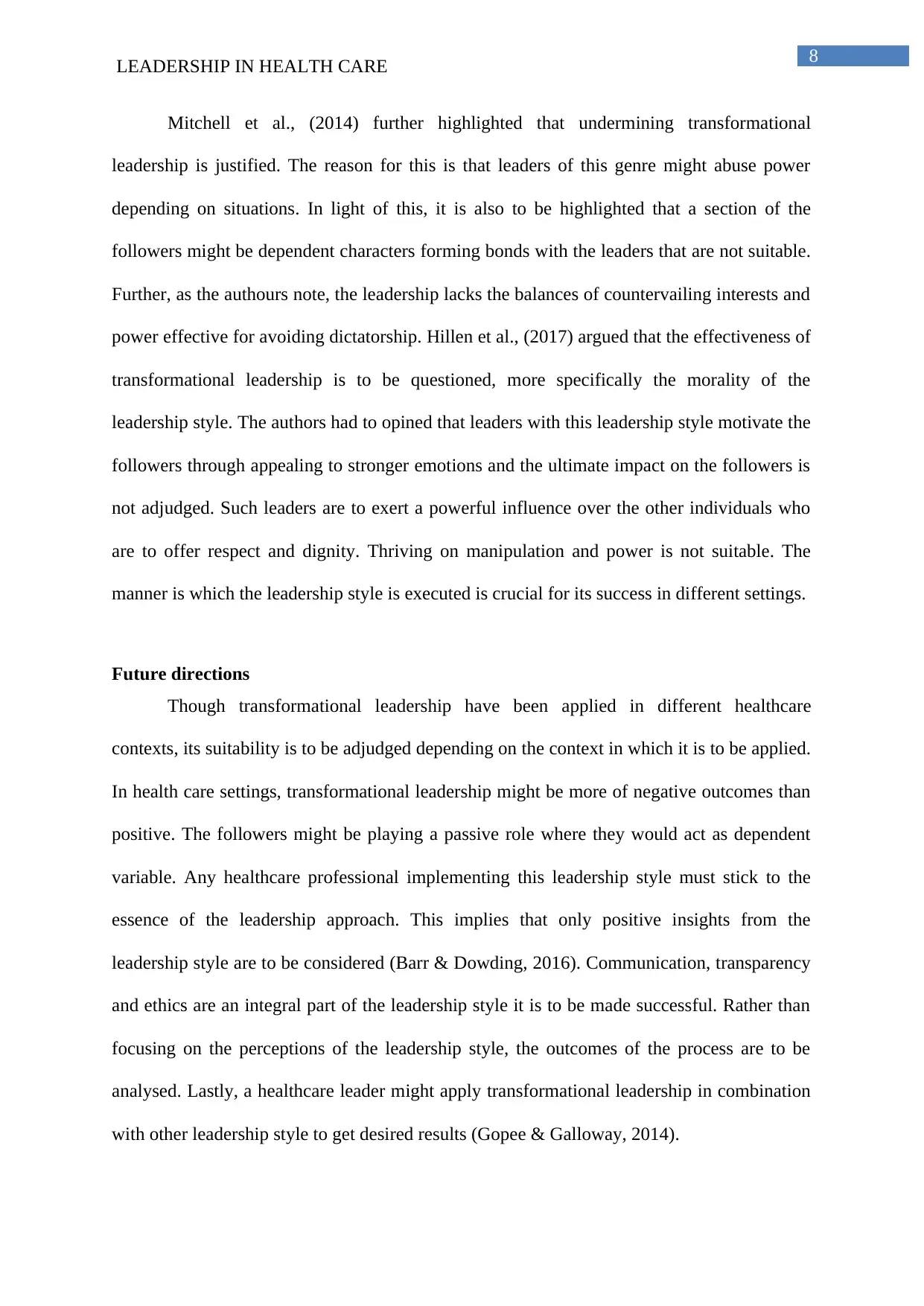
8
LEADERSHIP IN HEALTH CARE
Mitchell et al., (2014) further highlighted that undermining transformational
leadership is justified. The reason for this is that leaders of this genre might abuse power
depending on situations. In light of this, it is also to be highlighted that a section of the
followers might be dependent characters forming bonds with the leaders that are not suitable.
Further, as the authours note, the leadership lacks the balances of countervailing interests and
power effective for avoiding dictatorship. Hillen et al., (2017) argued that the effectiveness of
transformational leadership is to be questioned, more specifically the morality of the
leadership style. The authors had to opined that leaders with this leadership style motivate the
followers through appealing to stronger emotions and the ultimate impact on the followers is
not adjudged. Such leaders are to exert a powerful influence over the other individuals who
are to offer respect and dignity. Thriving on manipulation and power is not suitable. The
manner is which the leadership style is executed is crucial for its success in different settings.
Future directions
Though transformational leadership have been applied in different healthcare
contexts, its suitability is to be adjudged depending on the context in which it is to be applied.
In health care settings, transformational leadership might be more of negative outcomes than
positive. The followers might be playing a passive role where they would act as dependent
variable. Any healthcare professional implementing this leadership style must stick to the
essence of the leadership approach. This implies that only positive insights from the
leadership style are to be considered (Barr & Dowding, 2016). Communication, transparency
and ethics are an integral part of the leadership style it is to be made successful. Rather than
focusing on the perceptions of the leadership style, the outcomes of the process are to be
analysed. Lastly, a healthcare leader might apply transformational leadership in combination
with other leadership style to get desired results (Gopee & Galloway, 2014).
LEADERSHIP IN HEALTH CARE
Mitchell et al., (2014) further highlighted that undermining transformational
leadership is justified. The reason for this is that leaders of this genre might abuse power
depending on situations. In light of this, it is also to be highlighted that a section of the
followers might be dependent characters forming bonds with the leaders that are not suitable.
Further, as the authours note, the leadership lacks the balances of countervailing interests and
power effective for avoiding dictatorship. Hillen et al., (2017) argued that the effectiveness of
transformational leadership is to be questioned, more specifically the morality of the
leadership style. The authors had to opined that leaders with this leadership style motivate the
followers through appealing to stronger emotions and the ultimate impact on the followers is
not adjudged. Such leaders are to exert a powerful influence over the other individuals who
are to offer respect and dignity. Thriving on manipulation and power is not suitable. The
manner is which the leadership style is executed is crucial for its success in different settings.
Future directions
Though transformational leadership have been applied in different healthcare
contexts, its suitability is to be adjudged depending on the context in which it is to be applied.
In health care settings, transformational leadership might be more of negative outcomes than
positive. The followers might be playing a passive role where they would act as dependent
variable. Any healthcare professional implementing this leadership style must stick to the
essence of the leadership approach. This implies that only positive insights from the
leadership style are to be considered (Barr & Dowding, 2016). Communication, transparency
and ethics are an integral part of the leadership style it is to be made successful. Rather than
focusing on the perceptions of the leadership style, the outcomes of the process are to be
analysed. Lastly, a healthcare leader might apply transformational leadership in combination
with other leadership style to get desired results (Gopee & Galloway, 2014).
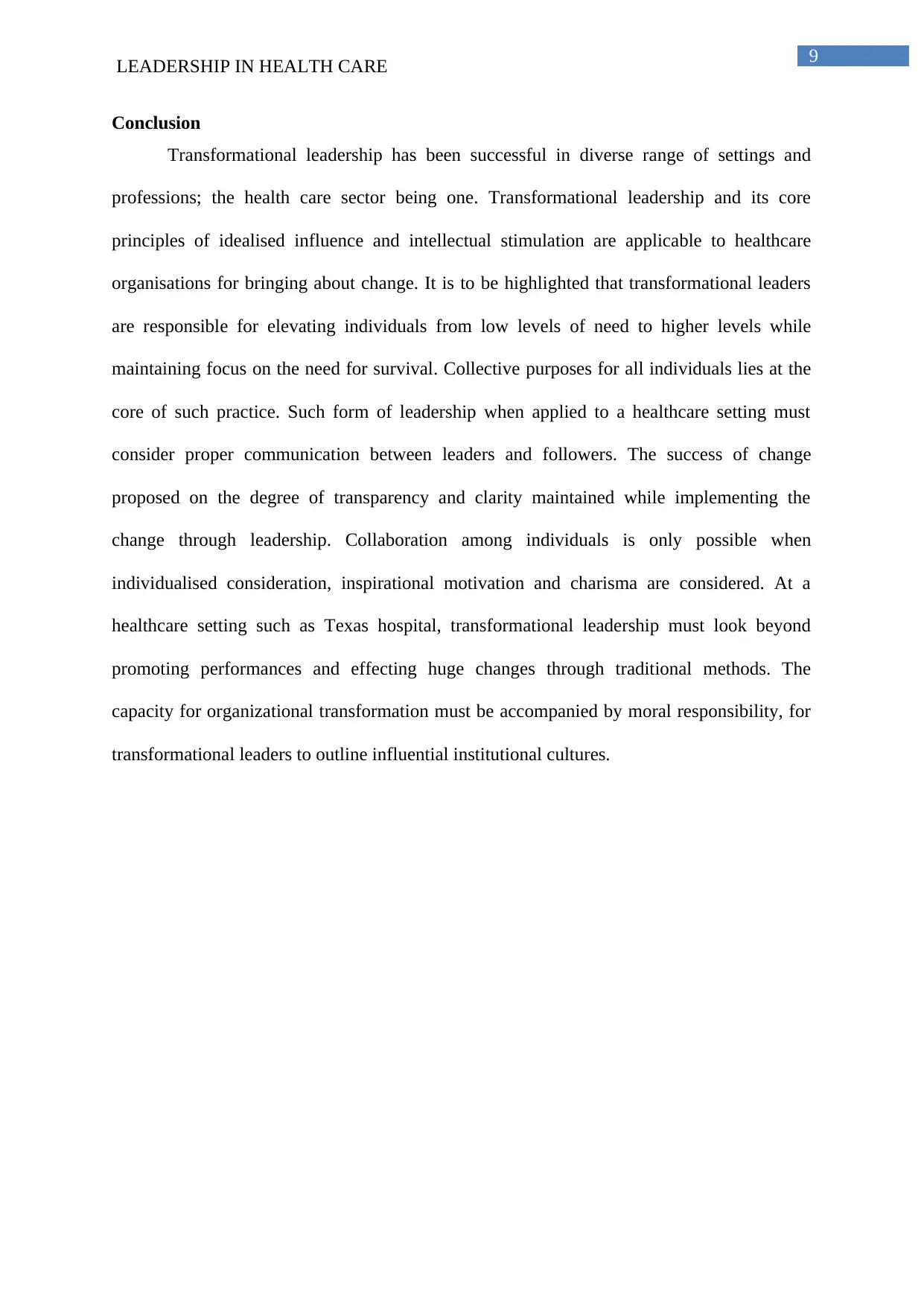
9
LEADERSHIP IN HEALTH CARE
Conclusion
Transformational leadership has been successful in diverse range of settings and
professions; the health care sector being one. Transformational leadership and its core
principles of idealised influence and intellectual stimulation are applicable to healthcare
organisations for bringing about change. It is to be highlighted that transformational leaders
are responsible for elevating individuals from low levels of need to higher levels while
maintaining focus on the need for survival. Collective purposes for all individuals lies at the
core of such practice. Such form of leadership when applied to a healthcare setting must
consider proper communication between leaders and followers. The success of change
proposed on the degree of transparency and clarity maintained while implementing the
change through leadership. Collaboration among individuals is only possible when
individualised consideration, inspirational motivation and charisma are considered. At a
healthcare setting such as Texas hospital, transformational leadership must look beyond
promoting performances and effecting huge changes through traditional methods. The
capacity for organizational transformation must be accompanied by moral responsibility, for
transformational leaders to outline influential institutional cultures.
LEADERSHIP IN HEALTH CARE
Conclusion
Transformational leadership has been successful in diverse range of settings and
professions; the health care sector being one. Transformational leadership and its core
principles of idealised influence and intellectual stimulation are applicable to healthcare
organisations for bringing about change. It is to be highlighted that transformational leaders
are responsible for elevating individuals from low levels of need to higher levels while
maintaining focus on the need for survival. Collective purposes for all individuals lies at the
core of such practice. Such form of leadership when applied to a healthcare setting must
consider proper communication between leaders and followers. The success of change
proposed on the degree of transparency and clarity maintained while implementing the
change through leadership. Collaboration among individuals is only possible when
individualised consideration, inspirational motivation and charisma are considered. At a
healthcare setting such as Texas hospital, transformational leadership must look beyond
promoting performances and effecting huge changes through traditional methods. The
capacity for organizational transformation must be accompanied by moral responsibility, for
transformational leaders to outline influential institutional cultures.
⊘ This is a preview!⊘
Do you want full access?
Subscribe today to unlock all pages.

Trusted by 1+ million students worldwide
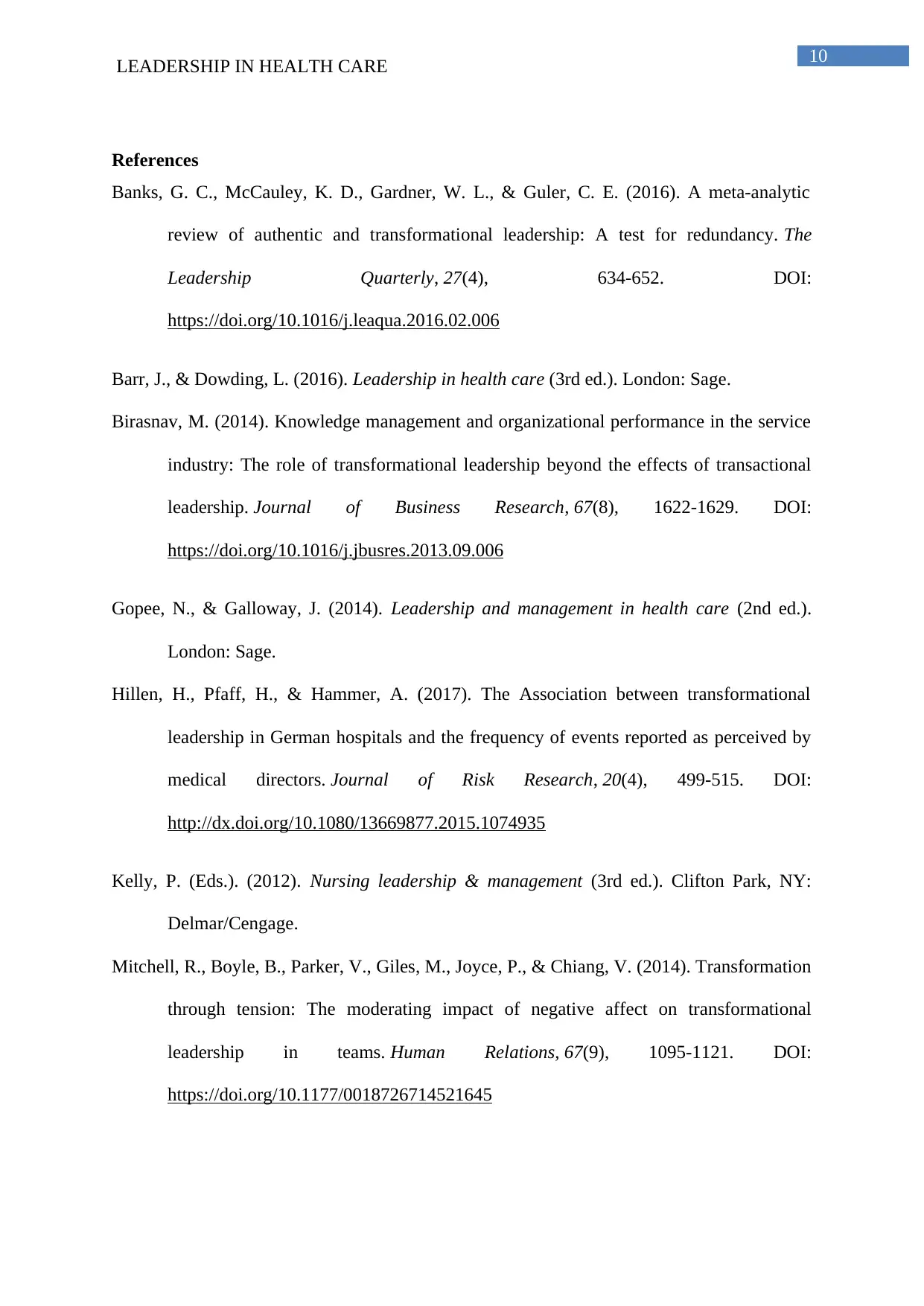
10
LEADERSHIP IN HEALTH CARE
References
Banks, G. C., McCauley, K. D., Gardner, W. L., & Guler, C. E. (2016). A meta-analytic
review of authentic and transformational leadership: A test for redundancy. The
Leadership Quarterly, 27(4), 634-652. DOI:
https://doi.org/10.1016/j.leaqua.2016.02.006
Barr, J., & Dowding, L. (2016). Leadership in health care (3rd ed.). London: Sage.
Birasnav, M. (2014). Knowledge management and organizational performance in the service
industry: The role of transformational leadership beyond the effects of transactional
leadership. Journal of Business Research, 67(8), 1622-1629. DOI:
https://doi.org/10.1016/j.jbusres.2013.09.006
Gopee, N., & Galloway, J. (2014). Leadership and management in health care (2nd ed.).
London: Sage.
Hillen, H., Pfaff, H., & Hammer, A. (2017). The Association between transformational
leadership in German hospitals and the frequency of events reported as perceived by
medical directors. Journal of Risk Research, 20(4), 499-515. DOI:
http://dx.doi.org/10.1080/13669877.2015.1074935
Kelly, P. (Eds.). (2012). Nursing leadership & management (3rd ed.). Clifton Park, NY:
Delmar/Cengage.
Mitchell, R., Boyle, B., Parker, V., Giles, M., Joyce, P., & Chiang, V. (2014). Transformation
through tension: The moderating impact of negative affect on transformational
leadership in teams. Human Relations, 67(9), 1095-1121. DOI:
https://doi.org/10.1177/0018726714521645
LEADERSHIP IN HEALTH CARE
References
Banks, G. C., McCauley, K. D., Gardner, W. L., & Guler, C. E. (2016). A meta-analytic
review of authentic and transformational leadership: A test for redundancy. The
Leadership Quarterly, 27(4), 634-652. DOI:
https://doi.org/10.1016/j.leaqua.2016.02.006
Barr, J., & Dowding, L. (2016). Leadership in health care (3rd ed.). London: Sage.
Birasnav, M. (2014). Knowledge management and organizational performance in the service
industry: The role of transformational leadership beyond the effects of transactional
leadership. Journal of Business Research, 67(8), 1622-1629. DOI:
https://doi.org/10.1016/j.jbusres.2013.09.006
Gopee, N., & Galloway, J. (2014). Leadership and management in health care (2nd ed.).
London: Sage.
Hillen, H., Pfaff, H., & Hammer, A. (2017). The Association between transformational
leadership in German hospitals and the frequency of events reported as perceived by
medical directors. Journal of Risk Research, 20(4), 499-515. DOI:
http://dx.doi.org/10.1080/13669877.2015.1074935
Kelly, P. (Eds.). (2012). Nursing leadership & management (3rd ed.). Clifton Park, NY:
Delmar/Cengage.
Mitchell, R., Boyle, B., Parker, V., Giles, M., Joyce, P., & Chiang, V. (2014). Transformation
through tension: The moderating impact of negative affect on transformational
leadership in teams. Human Relations, 67(9), 1095-1121. DOI:
https://doi.org/10.1177/0018726714521645
Paraphrase This Document
Need a fresh take? Get an instant paraphrase of this document with our AI Paraphraser
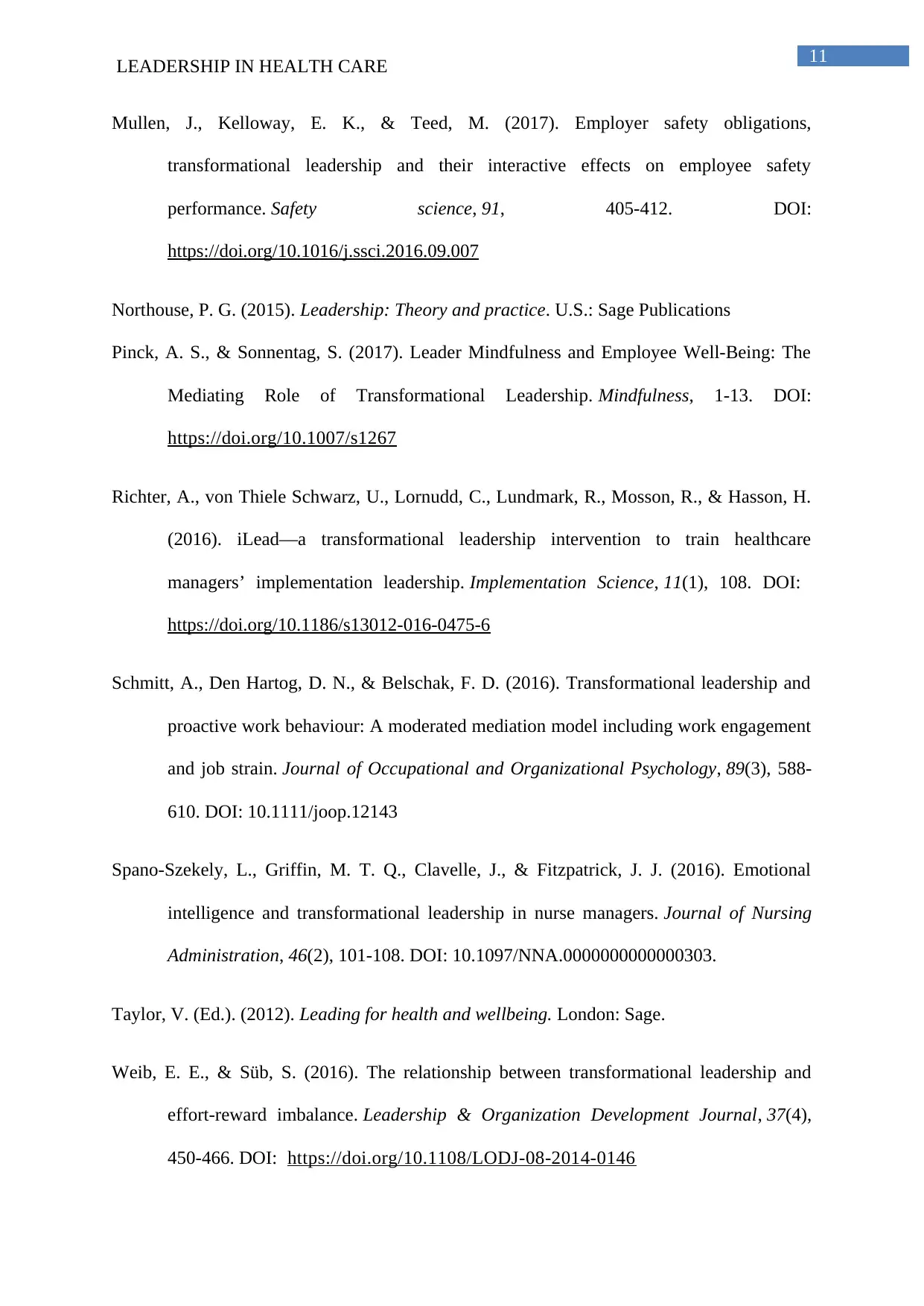
11
LEADERSHIP IN HEALTH CARE
Mullen, J., Kelloway, E. K., & Teed, M. (2017). Employer safety obligations,
transformational leadership and their interactive effects on employee safety
performance. Safety science, 91, 405-412. DOI:
https://doi.org/10.1016/j.ssci.2016.09.007
Northouse, P. G. (2015). Leadership: Theory and practice. U.S.: Sage Publications
Pinck, A. S., & Sonnentag, S. (2017). Leader Mindfulness and Employee Well-Being: The
Mediating Role of Transformational Leadership. Mindfulness, 1-13. DOI:
https://doi.org/10.1007/s1267
Richter, A., von Thiele Schwarz, U., Lornudd, C., Lundmark, R., Mosson, R., & Hasson, H.
(2016). iLead—a transformational leadership intervention to train healthcare
managers’ implementation leadership. Implementation Science, 11(1), 108. DOI:
https://doi.org/10.1186/s13012-016-0475-6
Schmitt, A., Den Hartog, D. N., & Belschak, F. D. (2016). Transformational leadership and
proactive work behaviour: A moderated mediation model including work engagement
and job strain. Journal of Occupational and Organizational Psychology, 89(3), 588-
610. DOI: 10.1111/joop.12143
Spano-Szekely, L., Griffin, M. T. Q., Clavelle, J., & Fitzpatrick, J. J. (2016). Emotional
intelligence and transformational leadership in nurse managers. Journal of Nursing
Administration, 46(2), 101-108. DOI: 10.1097/NNA.0000000000000303.
Taylor, V. (Ed.). (2012). Leading for health and wellbeing. London: Sage.
Weib, E. E., & Süb, S. (2016). The relationship between transformational leadership and
effort-reward imbalance. Leadership & Organization Development Journal, 37(4),
450-466. DOI: https://doi.org/10.1108/LODJ-08-2014-0146
LEADERSHIP IN HEALTH CARE
Mullen, J., Kelloway, E. K., & Teed, M. (2017). Employer safety obligations,
transformational leadership and their interactive effects on employee safety
performance. Safety science, 91, 405-412. DOI:
https://doi.org/10.1016/j.ssci.2016.09.007
Northouse, P. G. (2015). Leadership: Theory and practice. U.S.: Sage Publications
Pinck, A. S., & Sonnentag, S. (2017). Leader Mindfulness and Employee Well-Being: The
Mediating Role of Transformational Leadership. Mindfulness, 1-13. DOI:
https://doi.org/10.1007/s1267
Richter, A., von Thiele Schwarz, U., Lornudd, C., Lundmark, R., Mosson, R., & Hasson, H.
(2016). iLead—a transformational leadership intervention to train healthcare
managers’ implementation leadership. Implementation Science, 11(1), 108. DOI:
https://doi.org/10.1186/s13012-016-0475-6
Schmitt, A., Den Hartog, D. N., & Belschak, F. D. (2016). Transformational leadership and
proactive work behaviour: A moderated mediation model including work engagement
and job strain. Journal of Occupational and Organizational Psychology, 89(3), 588-
610. DOI: 10.1111/joop.12143
Spano-Szekely, L., Griffin, M. T. Q., Clavelle, J., & Fitzpatrick, J. J. (2016). Emotional
intelligence and transformational leadership in nurse managers. Journal of Nursing
Administration, 46(2), 101-108. DOI: 10.1097/NNA.0000000000000303.
Taylor, V. (Ed.). (2012). Leading for health and wellbeing. London: Sage.
Weib, E. E., & Süb, S. (2016). The relationship between transformational leadership and
effort-reward imbalance. Leadership & Organization Development Journal, 37(4),
450-466. DOI: https://doi.org/10.1108/LODJ-08-2014-0146

12
LEADERSHIP IN HEALTH CARE
LEADERSHIP IN HEALTH CARE
⊘ This is a preview!⊘
Do you want full access?
Subscribe today to unlock all pages.

Trusted by 1+ million students worldwide
1 out of 12
Related Documents
Your All-in-One AI-Powered Toolkit for Academic Success.
+13062052269
info@desklib.com
Available 24*7 on WhatsApp / Email
![[object Object]](/_next/static/media/star-bottom.7253800d.svg)
Unlock your academic potential
Copyright © 2020–2025 A2Z Services. All Rights Reserved. Developed and managed by ZUCOL.





